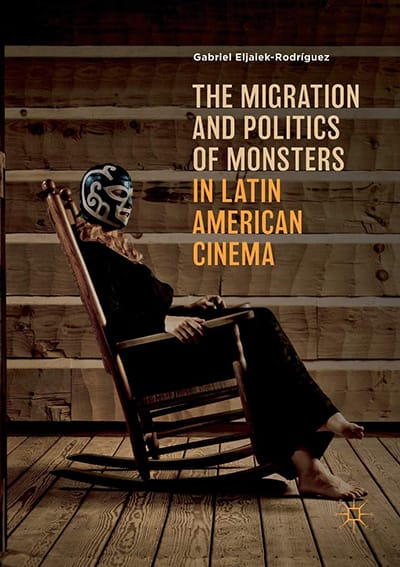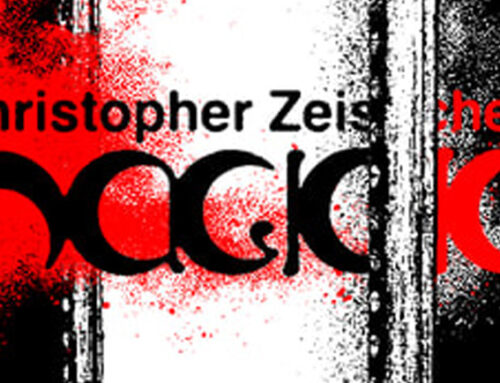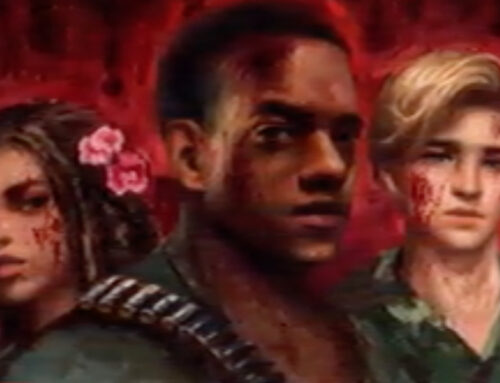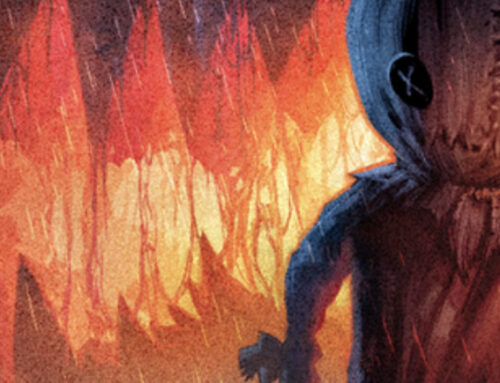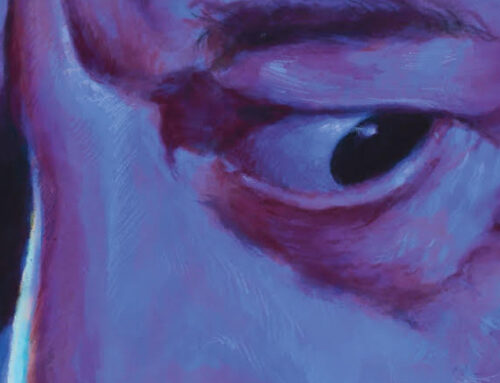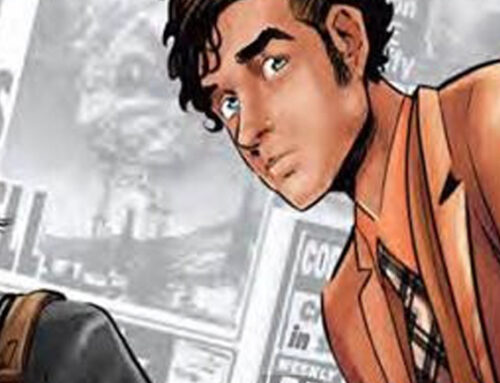In the horror cinema of Latin America, monsters have been heavily influenced by the diverse cultural, political, social, and blood-drenched history of Latin America.
The Migration and Politics of Monsters by Dr. Gabriel Eljaiek-Rodríguez dives deeply into contemporary Latin American horror cinema and how Latin American horror filmmakers are using monsters to reflect the monstrosities of Latin America past and present.
Currently, a professor at Spelman College in Atlanta, Georgia, Eljaiek-Rodríguez, a native of Bogotá, Colombia, specializes in the unique relationship between cinema and politics, with an emphasis on horror and gothic cinema. He has also explored other related cinematic topics in his other books, including Colombian Gothic in Cinema and Literature, Baroque Aesthetics in Contemporary American Horror, and Selva de fantasmas: El gótico en la literatura y el cine latinoamericanos.
Eljaiek-Rodríguez shares with us how became interested in international cinema, his passion for horror, how myths developed during colonialism still impact Latin American culture, and the future of Latin American horror cinema.
Bonilla: What started your interest in film?
Eljaiek-Rodriguez: In my city, Bogotá, you can find a lot of cinema. Mainstream theaters but also smaller venues. You can find movies from anywhere, from the US, Europe, Asia, and Latin America. There are also a lot of “cine clubs”. For example, some universities have their own cinema club, little holes in the wall that show really amazing films. You have a lot of variety, a gigantic variety of films.
Growing up, I remember going to a lot of cinema festivals. One week you had a festival of European cinema, and then two weeks later, there will be a Japanese film festival. The coming month there was a Turkish cinema festival, and so on. Some other times, there were festivals dedicated to particular filmmakers: Federico Fellini, Ingmar Bergman, David Lynch, Abbas Kiarostami, etc. I was exposed to a lot of cinema since I was a teenager and I think that this made me a little bit obsessed with movies. In Latin America, we receive a lot of Hollywood cinema and that is OK, but I was fortunate enough to watch many other forms of cinema as well. This is one of the biggest reasons why I am interested in cinema in general.
When did your interest in Latin American Cinema start?
It is connected with the fact that I was able to watch movies from so many different places around the world, including many from Latin America.
I studied psychology in college and liked certain elements of being a psychologist. But after graduating, I decided that I didn’t want to be treating patients. So, I started going more toward Latin American Cultural Studies and Latin American Film. I started seeing cinema as one of the places where cultures better manifest. You can learn quite a lot about the cultures of different places just by watching movies. Now, this is something that I already knew, but I started to pay a little more attention to movies made in Latin America.
Because of cultural imperialism, sometimes we tend to think that if a product or a cultural product comes from Europe or the U.S. it is intrinsically better. Watching movies from Latin America, my scope started changing and I started getting more interested in the cinema of the continent.
When I came to the U.S. to do my Ph.D., I thought, “I could watch films and write about films. I can transform these into my profession.” That was a revelation for me, and I was super happy. I also saw the extreme value of Latin American cinema, not only in terms of entertainment but also in terms of their ability to comment on social and political issues. For example, you watch Cantinflas and he’s very funny. His movies are amazing entertainment. But also his films are dealing with Mexican culture and social issues that were relevant when his movies came out.
So, I started seeing that a lot of nuances in Latin American films. Many film directors from Latin America are really talking about issues that are politically and socially important in Latin America, in dramas, historical dramas, comedies, etc. In most of the cinemas of Latin America, I would say there is a little bit of this component, a political component.
When I started traveling to different countries in Latin America, I was able to buy movies that I cannot find in Colombia or in the U.S. The first time I went to Mexico, for example, I bought many DVDs of El Santo films. Nowadays, it’s easier to find many different films on the internet, but not so much 10 or 15 years ago. All of these make Latin American films a point of focus. I’m very interested in cinema in general and I love cinema in general, but I wanted to focus my attention on Latin American cinema.
How did you get interested in Latin American horror cinema?
My mom likes to tell people that my aunt got me into horror, monsters, and things like that. When I was little, I sat with her and created stories about witches and vampires, illustrating them with drawings of these creatures. My dad also loved stories about aliens and paranormal stuff. In addition, T.V. shows like Scooby Doo, The Twilight Zone, or The X-Files also influenced my interest in horror, and later I got interested in U.S. American, European, and Asian horror cinema.
Also, since I was in Colombia, I have been reading Gothic literature. Initially, I read it in Spanish, but when I came to the U.S. I decided to re-read many of the Gothic classics in English. Carmilla, Dracula, Frankenstein, and The Monk were very influential in my Gothic education, and when I re-read them, I started to see parallels between some of the topics Stoker, Shelly, or Le Fanu use in their novels and topics used in Latin American literature. I started seeing that Julio Cortázar or Carlos Fuentes (among many others) were adapting and transforming elements from the European and U.S. American Gothic.
I started to see particularities in Latin American approaches to Gothic. Something that is separated from magical realism or fantastic literature – genres that are extraordinarily important in Latin America. But not everything is magical realism or fantastic literature on the continent. So I started moving towards Gothic literature and finding that in horror cinema in Latin America, there’s a lot of elements that are connected with the Gothic.
I worked on this in my dissertation – that became my first book. I focused on the Latin American Gothic and its developments and realized that there’s a lot of films that do not necessarily follow the conventions of this genre. So for my next book, I decided to focus more on horror and cinema, and on the political uses of horror in the continent.
What led you to connect politics to monsters in Latin American horror films?
In my opinion, when horror films represent monsters or horrors, they are both representing the scary monsters and something more than the monsters themselves. In this sense, Latin American horror films use monsters to tell a scary story but also to represent something that in most cases is social or political. This is something that I was already suggesting in my work on the Gothic and in some of the articles that I wrote before, so for my book, I decided to concentrate on Latin American horror and in the forms Latin American film directors use monsters and scary creatures to talk about the horrors of colonization, imperialism, poverty, classism, racism, xenophobia, etc.
Who would you consider the original monsters of the Americas?
In my book I try to show that America – and I’m talking about the continent, from Canada to Patagonia – have been conceived as a place of the monstrous since the beginning of the European colonization. The colonizers narrated the Indigenous groups as monsters and in doing so, transformed them into horrific Others. If the indigenous people were not accepting, or collaborating with the European colonization, they were presented as monsters, as barbarians – and as practitioners of one of the most horrific social taboos: cannibalism.
This is something that I talk with my students in my classes. It’s not that every single European during that time was horrible and wanted to kill Indigenous people (although many did). The colonizers needed to justify the conquest by showing the indigenous populations as barbaric or monstrous. If the indigenous groups were presented as flesh-eating monsters, it was “easier” to defend their eradication.
In this sense, the real monsters were the conquerors, the European colonizers. They arrived in the Americas saying, “First of all, all of this is ours. From now on, the name of this island is going to be this or that, and we don’t care if these places have a name already.” If we are going to say who is a real monster here, I would say that the ones that are imposing their beliefs, erasing, destroying, and killing entire communities are the ones that should be considered “monsters”. That’s a higher level of monstrosity than, “Oh my God, these people are naked, or they are eating with their hands”, or any of the signs of barbarism that the Europeans “saw.” Not of that was as bad as many of the things that some conquerors were doing.
In the book, some colonialists describe the Americas as, “A place of horror”, in regard to the Indigenous population and perceived cannibalism. Is that myth still impacting Latin America today?
Yes, and in similar ways. This is something that I have been working on recently, and that I describe as the “monsterfication” of Latin Americans – and also of Latinx populations. Is something that is present in politics, when we see and hear politicians saying that “all of these people” that are coming from Latin America are rapists, assassins, and gang members. Latin America and the Caribbean are still a place of fear for the West – and I am using the West as a synonym for the Global North.
In this perspective, Latin America is seen as a place full of drugs, violence, gangs, corruption, and other forms of horror. As Latin Americans, we recognize that the continent suffers from many of these problems, but it’s a gross generalization to represent the whole continent and its people only from negative stereotypes. Those who believe in these generalizations conceive the space between the Rio Grande and Patagonia as a place full of fear and monstrosity. But it is also a very hypocritical position since many U.S. Americans choose to visit Cancun or Punta Cana, but think that anywhere outside the all-inclusive resort, danger lurks in every dark corner.
I think the fear is pretty much alive. Frequently, we hear on the news from journalists, T.V. hosts, and politicians that Latin America and the Caribbean are places of horror and barbarism. Maybe they don’t use the word monster, but it is still a fear-inducing place.
So, the myth has gone from cannibals to narcos?
Exactly, from cannibals to narcos, gang members, and drug dealers. They have become one of the most prominent new monsters from the South. Obviously, there are narcos, and their presence is a grim reality in countries like Mexico and Colombia. But there are also narcos in the U.S. or in Europe. Sometimes that is the false dichotomy created by simplistic discourses: “We don’t have that here and all of them are coming from there. If they don´t come here we would be absolutely fine.” This transformation of the Latin American monstrosity has had many different names in history.
How did Juan of the Dead use a zombie invasion and its social downfall to depict the political unrest and communism in Cuba?
The zombie subgenre has evolved since 1968 with The Night of the Living Dead – the George A. Romero version of zombies. Since Romero, the zombie radically changes. They move faster. They are different, for example, from the 1930s zombies, present in movies like White Zombie and I Walked with a Zombie. Those are more like racialized ghouls.
The horde of zombies had been used as a metaphor for many different things. For example, as the communist masses in the 1970s and 80s zombie films. This Western fear that we are all going to be thinking the same, doing the same, and eating the same. So this fear manifests in a lot of films, where you see all of these masses coming to destroy individuality. That is something that many scholars have talked about in relation to the zombie subgenre.
What I think is very interesting is that Alejandro Brugués, the director of Juan of the Dead, flips this idea in his movie. In the sense he’s saying, “Finally, we’re gonna have zombies in a communist country.” So, what happens when the zombie apocalypse is happening in Cuba? It’s a very funny movie, but it has a very strong political subtext.
The first zombie that you see in the film is floating in the sea and wearing an orange jumpsuit, like the ones that prisoners wear in U.S. jails. In this sense, it is justified to say that this zombie is coming from Guantanamo Bay, the only place in Cuba that “belongs” to the U.S. So in that sense, I think that Brugués has a very smart way of flipping things. He’s saying that the zombie is not coming from the Caribbean anymore – as in most of the early zombie films. The zombies are coming from the US, and in that way, the movie is flipping the place of fear. It’s not the fear of communism anymore, but the fear of the U.S. empire.
In some way, he twists the zombie genre and this idea of the fear of the masses. He also questions the Cuban state and the Cuban mindset. For me, one of the most brilliant things about the film is when Brugués is questioning the incapacity of Cubans to see that something is strange because life in Cuba has been so strange (and difficult) for so long. In the movie, Juan takes a long time to see that something is weird and that Havana is becoming “zombified”. It’s not like that in other countries, where things are going crazy, and everyone realizes and freaks out. Here, it takes them a long time. Something is happening, but something is always happening in Cuba (an issue that the protagonist voices in the film). He’s making fun of the Cuban government as well, and this is something that, fortunately, the Cuban censorship didn’t catch.
There’s a moment when Juan receives a seemingly official phone call to use his killing zombie services, and because of the tone, we can only think that this is someone asking them to kill Fidel Castro. Then Juan’s like, “No, no, I cannot do that” in a very solemn voice. In his film, Brugués is making fun of a lot of things: Cuban idiosyncrasies, the Cuban Government, and communism. But also, using zombies to criticize or to talk about the fear of the expansion of the U.S. American Empire in the Caribbean and Latin America. I see it as a very interesting and important satire.
Guillermo Del Toro is described in your book as giving a facelift to Mexican horror in the 1990s. How did his interpretation of monsters reestablish monsters in his films?
Del Toro is a Latin American/Global director. It is amazing that he can do remarkable films in Mexico and remarkable films in the U.S. This is something that few Latin American directors have been able to do. So in that sense, he has been described as a very Mexican film director, but also as a global film director. One of the things that he does is reestablishing monsters and monstrosities in Mexico, but also questioning the monstrosity of Mexico. This is something that I have seen in all of his films – and in most of the films that I work on my book. Latin American film directors are saying, “Is Latin America really monstrous, or are the monsters coming from somewhere else? Or are we being labeled monsters because of these or that?” In that scene, Del Toro’s use of monstrosity is very clever.
In his first featured film, Cronos, he is really transforming the image of the vampire. This is extremely important, because of the significance of the vampire for the gothic genre, and for horror. Vampires are the major, extremely important creatures in Gothic canon. Del Toro brings it to Mexico and connects it with French alchemist Fulcanelli and with a magic/mechanical device. So he is bringing the vampire to Mexico, situating it in Mexico City, but also transforming it completely. His vampire is not an aristocrat anymore but instead, a mechanical insect, a device that hosts a blood-sucking insect-like creature.
In addition, when the protagonist transforms because of the creature´s sting, he becomes a pale and shiny humanoid. Del Toro´s vampire is a very important transformation that shows that there could be vampires in Mexico, but also questioning who is evil and where the evil comes from. In the film, the vampire is a grandpa, a very benevolent character. And the real evil of the film is the Mexican-American industrialist that only communicates in English.
What Del Toro does is connected with a practice that many Latin American film directors had done: saying, “If we’re going to talk about vampires, let’s talk about the country that have been sucking resources from Latin America for decades: the U.S.” That’s why a lot of the time vampires in Latin American horror films are monsters connected in some way with the U.S. and its history of exploitation of Latin America.
The protagonist in Cronos sucks blood and all of that. But at the end of the day, he is a caring grandparent. He’s not an evil count, just a nice guy that found the device and used it. The real bad guy in the film is this U.S. industrialist that mistreats everyone and wants to live forever and keep having his empire.
Del Toro continuously gives us complex monsters in his films. Either if the monsters or the characters are Latin American or if they come from other places. For example, The Devil’s Backbone and Pan’s Labyrinth narratives happen in Spain. In The Shape of Water, he keeps expanding the idea that these monsters have multiple nationalities, phases, and identities. And at the end of the day, he is always sympathetic with the monsters.
I think this sympathy is rooted in the idea of how, as Latin Americans, we have been described as monsters in many instances. If they describe us like monsters, okay, fine, we are. But we are going to sympathize, and we are going to show that at the end, sometimes the ones that are described as monstrous are monstrous at all. They could “look like” monsters, but they are not morally monstrous.
A lot of the time, the monsters in Del Toro films are good-looking guys. I’m thinking of The Shape of Water, where the agent guy is good-looking, but is a horrific character. The creature is just someone that wants to live and love. I think he changes the complexity of the monster. In some way, he reaches back to the 1931 version of Frankenstein. When the film is trying to show a little bit that maybe the monster is not as monstrous as it looks. I think Del Toro explores that complexity and false claims in most of his films.
How has Asian horror influenced contemporary Latin American horror?
It’s a stylistic but also a thematic influence. This is something that I have seen since the beginning of the first decade of the 2000s. It is very connected, of course, with the boom of what is called in the U.S. J-horror or K-horror – Japanese horror or Korean horror –, a huge filmic boom since 1999 and starting with Hideo Nakata’s Ringu.
Several Latin American directors have been using aesthetics and tropes of Asian cinema, specifically supernatural Asian horror. For example, the presence of the pale female ghost with long hair, wearing white a lot of the time. Also, the color palette of several Latin American horror films from the early 2000s is similar to Asian horror films: the use of greens, blues, and grays in confined spaces. For
example, Al final del espectro [At the End of the Specter] from Colombia, KM 31 [Kilometer 31] from Mexico, or Cementerio General [General Cemetery] from Peru. All of these films use these filters through the movies.
Obviously, we cannot ignore the fact that, if these directors or producers were aligning their films with an aesthetic that was important during the early 2000s, more people were going to watch their films. There is also a clear commercial interest. “We want more people to watch horror films, so what is trending out there?”
There is a thematic connection as well. Some of the films that adopted an Asian horror aesthetic are more explicit addressing, for example, violence against women. KM 31, for example, is a movie about La Llorona but is also talking about the hundreds of femicides occurring in Ciudad Juarez and El Paso. What better than a female ghost to talk about this? I think that in a very smart way, they are saying, “Vengeful female ghosts are good to address a topic that neither the U.S. government nor the Mexican government is addressing.” To give you another example, in several Peruvian horror films that are influenced by Asian horror, when the protagonists are trying to find the history behind the ghost, what they find out is a woman that was abused and killed by a lover – and this becomes the center of the story.
This reminds me of the Muschietti sibling’s films Mama and It. Mama had a tragic female ghost, while It had cinematography by the Korean horror master Chung-hoon Chung.
Exactly. I think it’s also because Asian cinema in some way redesigned many tropes of horror in the late 1990s and the beginning of the 21st century. For example, the way that many ghosts move in movies today – this kind of weird and unnatural movement – was created by Korean and Japanese cinematographers. It’s very unnerving when you are watching it, and the Muschiettis use it in their movies.
For Argentinian horror, your book connects slashers like Cold Sweat and Room for Tourists to the brutality of the Dirty War. How did they do that?
For slashers, in my book, I looked at Argentinian director Adrián García Bogliano, since many of his films are part of this subgenre. In Latin America, a lot of horror fans, including García Bogliano, grew up watching slasher films. When I first approached his work, I was thinking, “Why is that? Why is he so interested in working with this particular genre that is bloodier, full of guts and body parts? Way more in your face than other subgenres.”
In some way, I think that this interest could be connected with the bloody and horrific dictatorships that occurred in the Southern Cone in the second part of the 20th century. I’m talking about the Chilean dictatorship from 1973 to 1990, the Uruguayan dictatorship from 1973 to 1985, or the Argentinian dictatorship from 1976 to 1983 –among others. This period of time was marked by horrific, horrific violence. A lot of violence was not as visible in part because we are talking about right-wing dictatorships that were literally making people disappear. And there “disappearing” was a euphemism for torture and homicide.
Argentina, Chile, Uruguay, Brazil, and Paraguay were under ironclad right-wing dictatorships for decades. And of course, people were not able to critically talk about them. If they wanted to critically talk about the regime, they would have to either leave the country, or risk being incarcerated or killed. Following this, I started to see some of the horrors of the Argentine dictatorship in García Bogliano´s films, even if the narratives of the films happen in the present. On the surface everything is fine, but then you start seeing all of these horrific things and all of these horrific characters that still move in the shadows.
For example, one of the films that interested me more was Sudor frío [Cold Sweat]. It is particular that none of the bad guys in the film are supernatural at all – like Freddy Krueger or Jason Voorhes in U.S. slashers. In Sudor frío the bad guys are two old guys that used to work for the military dictatorship. In the film, it’s absolutely clear that these guys were trained to kill, they only know how to kill, and they enjoy doing it. In the present of the movie, they keep looking for communists and they keep targeting the population that they were targeting during the dictatorship: young people. And they kill them in these horrific, weirdly creative, and twisted ways using nitroglycerin.
I think that the Argentine society, 40 years later, is still recuperating from the horrors committed by the military in the 70s and 80s. It was something that really damaged the structure of society because people were not able to trust their neighbors anymore. Sometimes, entire families were accused by their neighbors of being “communists” and then the military police came and took the dad, the mom, and in many cases the kids.
It’s a society that is still hearing horrific stories from families and survivors. Sometimes we hear in the news about a grandmother who “found” her grandkids after 30 years because the kids were abducted and resituated with a family in Uruguay or Chile after their parents were killed by the military. It is a society that is still healing, and it makes a lot of sense that horror films are reflecting that.
Several of Bogliano´s films are talking about a surface layer that is apparently normal, but under that, you have all of these horrors lurking. It is like the little town in Room for Tourists. A small town that seems calm and sleepy, but that is inhabited by religious zealots who hunt young people that they deem to be sinners. Obviously, this aligns very well with the slasher genre, because the people that are being killed in these films are young people that dare to think different. So, in my opinion, slasher is a subgenre that works weirdly well to indirectly reference and bring up discussions about the brutality of the Argentinian dictatorship.
The final chapter looks at Andean horror, which has been overlooked by critics and is not well known by horror fans. Why do you think that is?
I can think of two reasons. First, I would say it very directly, is because of racism and classism. Because racism and classism in Latin America go together. The fact that a lot of these films that I am grouping as Andean horror are made in areas that are mostly indigenous, and they focus on indigenous myths, make them less desirable for distributors that want to cater to whiter or mestizo audiences.
The second reason is connected to the production value. A lot of these films are very artisanal and made with small budgets, so they are read as “B” films –if not “C” or “D” – by audiences that are used to Hollywood blockbusters. That being said, films like Qarqacha: El Demonio del Incesto could be difficult to watch, in the sense that the camera is a little bit shaky, and the actors are natural actors, as opposed to professionals. A lot of the time they overact or underact because they are not necessarily trained.
Many of these films didn´t reach the cinemas in Lima [Peru] or in the big cities – at least not when they were released. However, a lot of them were very recognized in rural areas. Some of these films were shown in rural town cinemas, and everyone in those towns went to see the film because they wanted to see themselves, or their friends, in the movies. Because of this, the films in this category were not touched by Peruvian producers or distributors, let alone other Latin American distributors.
We are used to a particular film quality, and some of these films don´t necessarily adjust to traditional cinematic parameters. Nonetheless, they are narrating particular stories that are important for Andean rural and indigenous communities. In addition, there is a stereotype that Bolivian cinema or Peruvian cinema are not good, and that is a lie. They have great movies and great directors. They have a smaller industry, yes, but that doesn’t mean that they are not good.
What do you hope readers will take away from this book?
I would like people to know (and learn) that there is a tradition of Latin American horror that is old, established, frequently critical, and really good. That’s something that a lot of people are not aware of. Usually, when people outside of Latin America think about movies or shows from Latin America, they only think about telenovelas [soap operas]. That’s the only reference. If someone knows a little bit more about Latin American cinema, maybe they recognize some dramas, outstanding films like City of God or Amores perros, or some documentaries about poverty and civil unrest – but no more than that.
One of my favorite things to point out is how a lot of Latin American horror is political. It’s continuously challenging the idea of Latin American monstrosity. In some ways, it shows how we have been depicted this way, and how we keep being depicted like that. But it also keeps asking questions like, where are the monsters really coming from? and, who is the monster in reality? The Spanish conquistadors claimed that the Indigenous people were cannibals and were constantly looking for cyclops and dog-headed people in the Americas. None of those things were there. At the end of the day, they were the ones killing, raping, and destroying. So who really is the monster?
The horror genre in general and Latin American horror in particular, approach this criticism without being preachy, or without being overtly transparent. That is great because it is very rare that audiences if they want to entertain themselves, go to watch a documentary. If you have a little time to watch a movie to entertain yourself, maybe you will go watch a comedy, an action film, or a horror film. In my opinion, it’s very smart that horror does these kinds of things because it can reach more people. If you are watching a film about a monster or a ghost you are not necessarily thinking, “Oh, I’m learning about Latin American history, politics, or culture.” But in some way, you’re doing it when you’re watching one of those films, without knowing. That’s something I want people to see.
For horror fans interested in learning more about Latin American horror films, which films would you recommend?
There are many different traditions. If someone is interested in gothic horror, Hasta el viento tiene miedo [Even the Wind is Afraid] or El libro de Piedra [The Stone Book] by Carlos Enrique Taboada are amazing and atmospheric classics –from the 1960s. Earlier I mentioned Cronos by Del Toro. I think Cronos is already a wonderful classic of Latin American horror. And I will add KM 31, centered in La Llorona legend.
I will also mention the Colombian films, Carne de tu carne [Flesh of Your Flesh] from Carlos Mayolo, Pura sangre [Pure Blood] from Luis Ospina, and El Páramo, which was translated in the US as The Squad. Also, as we talked about, Juan de los Muertos [Juan of the Dead]. A horrifically funny film.
There have also been a lot of good horror films coming out of Latin America in recent years. One of the best ones that I have seen is called Aterrados [Terrified]. Is an Argentinean film from 2018, with impeccable production and a really good story. Another great contemporary film is La Llorona, directed by Guatemalan filmmaker Jayro Bustamante in 2019. This is an incredible film in terms of production and filmic qualities, but also as a reinterpretation of the Pan-Hispanic Llorona legend. Bustamante uses the legend of La Llorona to talk about the Guatemalan dictatorship – one of the bloodiest in the 20th century – and to punish a dictator that was never brought to justice in real life.
What do you see as the future of monsters in Latin American horror?
I think Latin American horror will keep producing more hybrid monstrosities. This is a term that I use a lot in my work. Latin American writers and directors frequently take monstrosities from different places in the world and transform them into something that is recognizable as Latin American. For example, in the Colombian films I mentioned before, the vampires are sugar landowners and not European Counts. We are not in Transylvania anymore. They are Colombian elites sucking the blood of the peasants, but they are still vampires and recognizable as such. In my opinion, Latin America will keep producing these hybrid monsters that criticize their own elites and their own problems, at the same time that they show the horrors of imperialism that comes from the US, Europe, or any other place in the world.
Additionally, we have more Afro-Latin American directors that are from Latin America or have roots in the continent, as well as directors putting their signatures on a lot of different high-end projects, like Muschietti or Del Toro.
How do Latino directors of American horror play a role in Latin American horror?
Currently, I’m working on how to read the interconnections between Latin American horror films and films made in the U.S. by Latinx directors. That is another layer, and a very interesting and important one. For example, a film like The Forever Purge is clearly showing the horrors of a deeply racist and xenophobic group of people that you can find in many places in the contemporary U.S. In this case, it’s not an abstract, or imaginary monster. It is real monstrosity that is very much alive.
I will keep working on Latin American cinema, but I think that it’s also very important to look at what Latinx directors are doing in the U.S. They have a foot on both sides, in Latin America, and in the U.S., their movies are showing that.
Book available on Amazon: https://www.amazon.com/Migration-Politics-Monsters-American-Cinema/dp/3030073246

